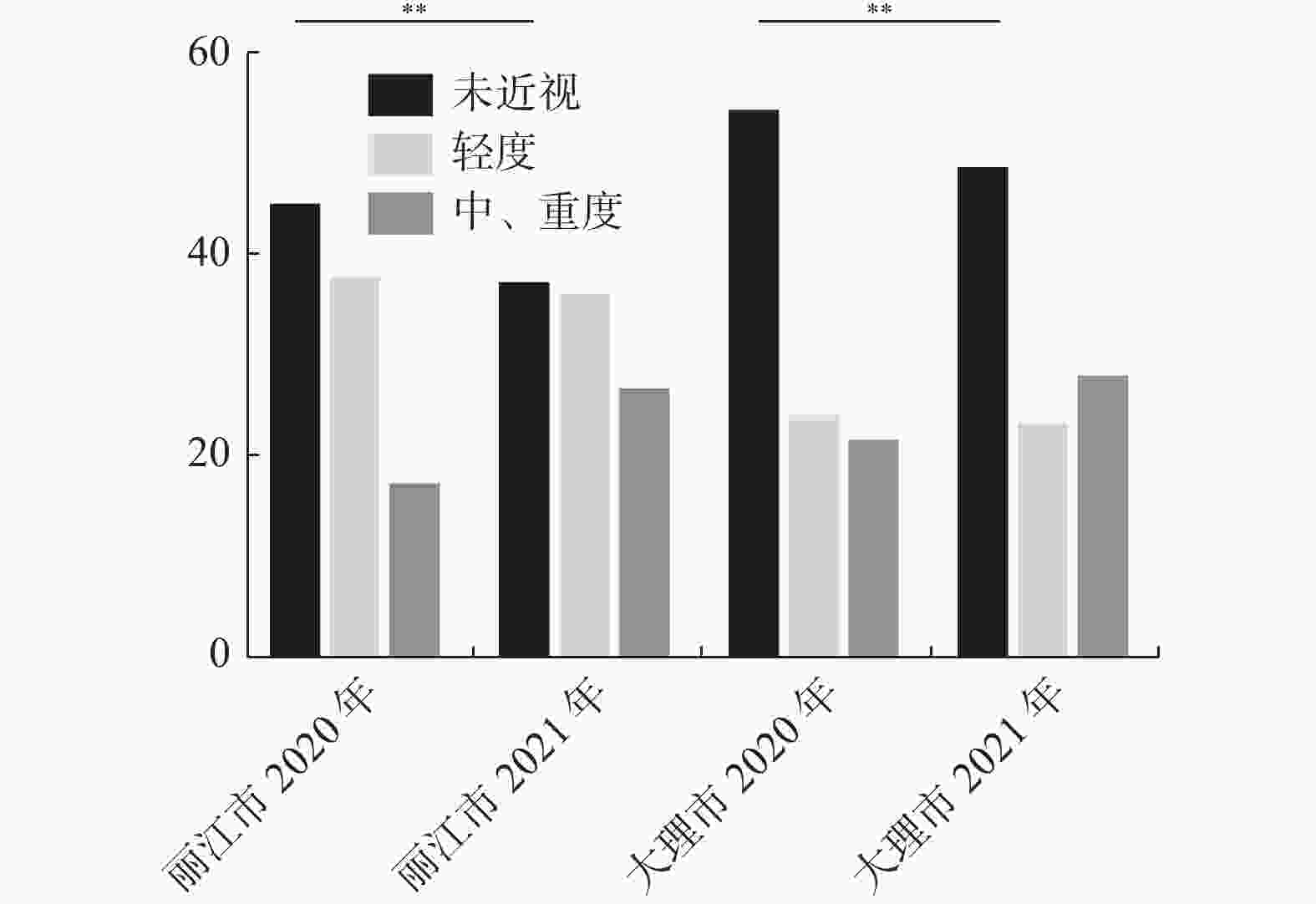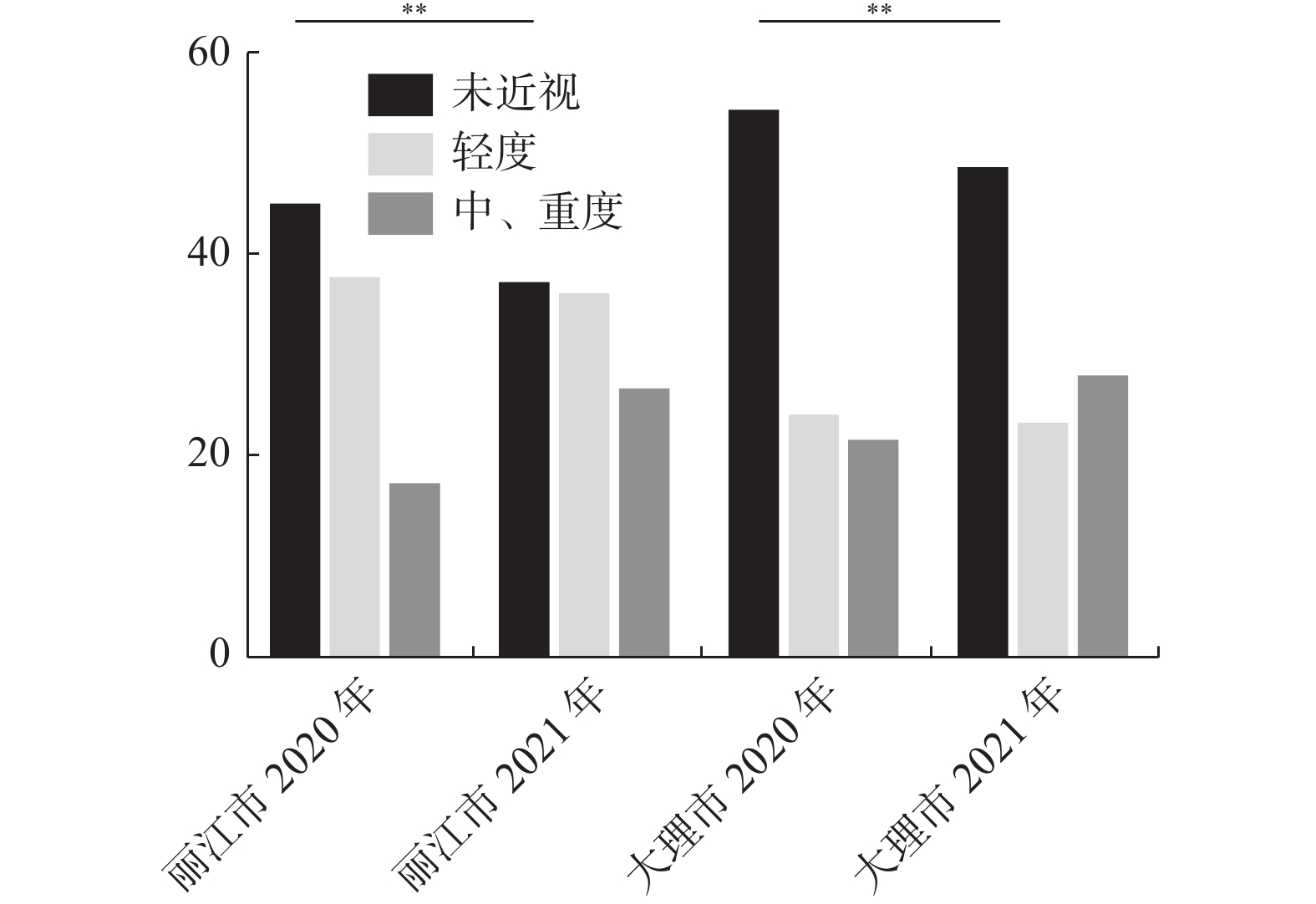Screening Myopia Rate among Primary and Secondary School Students in Lijiang and Dali during the COVID-19 Epidemic
-
摘要:
目的 分析新冠疫情期间丽江市、大理市2 a筛查性近视率,并分析近视相关影响因素。 方法 随机整群抽取774名学生作为研究对象,于2020年10月和2021年9月分别对同一研究人群使用台式全自动电脑验光仪进行眼部检测,获得其眼睛客观指标。根据问卷调查表内容采用Logistic回归分析近视的影响因素。 结果 丽江市、大理市2 a中小学生总体筛查性近视率分别为55.0%、62.8%,45.7%、51.4%。两地结果均显示女生近视率高于男生、初中学生近视率高于小学学生(P < 0.05)。与2020年相比,2021年丽江市学生每天多媒体教学时间越来越长、每天做作业时间在不断减少、睡前玩手机的人数不断增加、户外活动时间不断增加(P < 0.05);2021年大理市学生每天多媒体教学时间越来越长、每天做作业时间在不断减少、户外活动时间不断增加、球类运动时间不断增加(P < 0.05)。Logistic回归分析,丽江市2020年结果显示,女生、初中学生、课间休息在教学楼内活动、总是吃动物肝脏、总是吃甜食、总是喝含糖饮料是导致学生患近视的危险因素(P < 0.05);2021年结果显示,女生、初中学生、户外活动>2 h、总是吃甜食是导致学生患近视的危险因素(P < 0.05)。大理市2020年结果显示,初中学生、最早看书年龄为5~6岁、父母都不近视是导致学生患近视的危险因素(P < 0.05);2021年结果显示,初中学生、总是吃甜食是导致学生患近视的危险因素(P < 0.05)。 结论 两地学生疫情期间用眼时长不断增加,近视率不断增加且存在性别、学段差异,应重点关注初中学生特别是女生视力情况。学生近视影响因素复杂,户外活动时间>2 h、课间休息在教学楼内活动、总是吃动物动物肝脏、总是吃甜食、总是喝含糖饮料、看书年龄为5~6岁、父母都不近视是导致学生近视的危险因素。应针对易于改变的危险因素,加强近视防治知识宣传,采取干预措施,防止近视的发生发展。 Abstract:Objective To analyze the 2-year screening myopia rate in Lijiang City and Dali City during the COVID-19 pandemic and analyze the related influencing factors of myopia. Methods A total of 774 students were randomly selected as the research subjects. In October 2020 and September 2021, the eyes of the same study population were tested by desktop automatic computer refractometer, and the objective indicators of their eyes were obtained. Logistic regression was used to analyze the influencing factors of myopia. Results The overall screening myopia rates of 2-year primary and secondary school students in Lijiang City and Dali City were 55.0%, 62.8% and 45.7%, 51.4%, respectively. The results showed that in both cities the myopia rate of female students was higher than that of male students, and the myopia rate of junior middle school students was higher than that of primary school students (P < 0.05). Compared with 2020, the daily multimedia teaching time of students in Lijiang City was getting longer, the daily homework time was decreasing, the number of students playing mobile phones before bed was increasing, and the outdoor activity time was increasing in 2021 (P < 0.05); the daily multimedia teaching time of students in Dali City was getting longer, the daily homework time was decreasing, the outdoor activity time was increasing, and the ball game time was increasing in 2021(P < 0.05). Logistic regression analysis showed that in Lijiang City in 2020,girls,junior high school students, recess in the teaching building, always eating animal liver, always eating sweets, always drinking sugary drinks were risk factors for myopia (P < 0.05). In 2021, girls, junior high school students, outdoor activities >2 h, always eating sweets were risk factors for myopia (P < 0.05). In Dali City in 2020, junior high school students, the earliest reading age was 5~6 years old, and neither parents were myopic were risk factors for myopia (P < 0.05). In 2021,junior high school students, always eating sweets were risk factors for myopia (P < 0.05). Conclusion During the epidemic period, the eye time of students in the two places was increasing, and the myopia rate was increasing, with gender and school stage differences. We should focus on the vision of junior high school students, especially girls. The influencing factors of myopia in students are complex.Outdoor activities > 2 h, recess in the teaching building, always eating animal liver, always eating sweets, always drinking sugary drinks, reading age of 5~6 years old, and neither parents were myopic were risk factors for myopia in students. According to the risk factors that are easy to change, we should strengthen the publicity of myopia prevention and treatment knowledge, and take intervention measures to prevent the occurrence and development of myopia. -
Key words:
- Myopia /
- Primary and secondary school students /
- Ethnic /
- COVID-19
-
表 1 不同人口学特征学生筛查性近视率比较[n(%)]
Table 1. Comparison of screening myopia rates among students with different demographic characteristics [n(%)]
年份 指标 丽江市 大理市 n 近视人数 χ2 P n 近视人数 χ2 P 2020年 性别 男 187 91(48.7) 6.091 0.014* 211 88(41.7) 2.787 0.095 女 184 113(61.4) 192 96(50.0) 年级 小学 134 53(39.6) 20.189 <0.001** 201 37(18.4) 120.010 <0.001** 初中 237 151(63.7) 202 147(72.8) 民族 汉族 143 82(53.7) 0.609 0.738 152 68(44.7) 3.304 0.192 纳西族 223 119(53.4) _ _ _ _ 白族 _ _ _ _ 181 90(49.7) 其他 5 3(60.0) 70 26(37.1) 合计 371 204(55.0) 403 184(45.7) 2021年 性别 男 187 107(57.2) 5.033 0.025* 211 104(49.3) 0.764 0.382 女 184 126(68.5) 192 103(53.6) 年级 小学 134 62(46.3) 24.549 <0.001** 201 44(21.9) 139.450 <0.001** 初中 237 171(72.2) 202 163(80.7) 民族 汉族 143 97(67.8) 2.519 0.284 152 83(54.6) 2.043 0.360 纳西族 223 133(59.6) _ _ _ _ 白族 _ _ _ _ 181 93(51.4) 其他 5 3(60.0) 70 31(44.3) 合计 371 233(62.8) 403 207(51.4) *P < 0.05,**P < 0.001。 表 2 各类用眼时间、屏幕使用时间分布比较[n(%)]
Table 2. Comparison of the distribution of various types of eye use and screen time [n(%)]
选项 丽江市 大理市 2020年 2021年 H/Z P 2020年 2021年 H/Z P 每天多媒体教学时间(h) 5.139 0.023* 34.753 <0.001** <2 201(54.2) 176(47.4) 234(58.1) 157(39.0) 2~4 124(33.4) 126(34.0) 119(29.5) 145(36.0) >4 46(12.4) 69(18.6) 50(12.4) 101(25.1) 每天做作业时间(h) 2.974 <0.001** 3.628 <0.001** <2 187(50.4) 268(72.2) 143(35.5) 246(61.0) >2 184(49.6) 103(27.8) 260(64.5) 157(39.0) 每天看电视时间(h) 1.481 0.224 0.054 0.816 0 27(7.3) 28(7.5) 43(10.7) 57(14.1) <1 167(45.0) 147(39.6) 211(52.4) 191(47.4) >1 177(47.7) 196(52.8) 149(37.0) 155(38.5) 每天用电脑时间(h) 0.744 0.388 4.680 0.031* 0 208(56.1) 200(53.9) 238(59.1) 206(51.1) <1 112(30.2) 108(29.1) 128(31.8) 154(38.2) >1 51(13.7) 63(17.0) 37(9.2) 43(10.7) 睡前是否玩手机 1.615 0.011* 0.881 0.420 否 246(66.3) 202(54.4) 293(72.7) 268(66.5) 是 125(33.7) 169(45.6) 110(27.3) 135(33.5) 每天户外活动时间(h) 22.306 <0.001** 12.609 <0.001** <1 92(24.8) 105(28.3) 111(27.5) 105(26.1) 1~2 128(34.5) 197(53.1) 137(34.0) 223(55.3) >2 151(40.7) 69(18.6) 155(38.5) 75(18.6) 每周球类运动时间(h) 0.835 0.361 1.135 0.287 <0.5 129(34.8) 139(37.5) 258(64.0) 127(31.5) 0.5~1 170(45.8) 168(45.3) 65(16.1) 137(34.0) >1 72(19.4) 64(17.3) 80(19.9) 139(34.5) 每天睡觉时间(h) 42.384 <0.001** 69.255 <0.001** <8 192(51.8) 92(24.8) 170(42.2) 185(45.9) 8~9 63(17.0) 107(28.8) 142(35.2) 135(33.5) >9 116(31.3) 172(46.4) 91(22.6) 83(20.6) *P < 0.05,**P < 0.001。 表 3 二元Logistic回归分析自变量赋值表
Table 3. Binary logistic regression analysis of independent variable assignment tables
自变量 变量名 赋值说明 性别 X1 男=1,女=2 年级 X2 小学=1,初中=2 最早看书年龄(岁) X3 1−2=1,2−3=2,3−4=3,4−5=4,5−6=5 课间休息在哪儿活动 X4 教学楼内=1,户外(如操场等)=2 眼睛距离电脑显示屏是否超过66 cm X5 从不=1,偶尔=2,经常=3,总是=4,从不看电脑=5 父母是否近视 X6 只有父亲近视=1,只有母亲近视=2,父母都近视=3,父母都不近视=4 户外活动时间(h) X7 <1=1,1−2=2,>2=3 吃动物肝脏吗 X8 从不=1,偶尔=2,经常=3,总是=4 吃深色蔬菜吗 X9 从不=1,偶尔=2,经常=3,总是=4 吃甜食吗 X10 从不=1,偶尔=2,经常=3,总是=4 喝含糖饮料吗 X11 从不=1,偶尔=2,经常=3,总是=4 表 4 丽江市学生近视影响因素分析
Table 4. Analysis of influencing factors of myopia among students in Lijiang City
年份 自变量 选项 β 标准误 χ2 P OR(OR 95%CI) 2020年 性别 男 −0.544 0.310 3.066 0.080 0.581(0.316~1.087) 班级 小学 −1.152 0.389 8.766 0.003** 0.316(0.147~0.677) 课间休息在哪里活动 教学楼内 1.145 0.316 13.104 <0.001** 3.143(1.691~5.842) 吃动物肝脏吗 从不 −3.195 1.457 4.807 0.028* 0.041(0.002~0.713) 偶尔 −3.133 1.409 4.945 0.026* 0.044(0.003~0.690) 经常 −3.278 1.490 4.837 0.028* 0.038(0.002~0.700) 吃深色蔬菜吗 从不 1.691 1.253 1.819 0.177 5.422(0.465~63.251) 偶尔 2.393 0.790 9.187 0.002* 10.951(2.330~51.479) 经常 2.143 0.748 8.200 0.004* 8.524(1.966~36.953) 吃甜食吗 从不 −0.323 2.447 0.017 0.895 0.724(0.006~87.650) 偶尔 3.082 1.125 7.509 0.006* 21.791(2.405~197.463) 经常 3.277 1.106 8.786 0.003* 26.500(3.035~231.394) 喝含糖饮料吗 从不 −1.879 1.376 1.863 0.172 0.153(0.010~2.268) 偶尔 −2.711 1.088 6.205 0.013* 0.066(0.008~0.561) 经常 −2.024 1.087 3.464 0.063 0.132(0.016~1.113) 2021年 性别 男 −0.695 0.286 5.931 0.015* 0.499(0.285~0.873) 年级 小学 −1.389 0.381 13.293 <0.001** 0.249(0.118~0.526) 户外活动时间(h) <1 0.580 0.405 2.051 0.152 1.786(0.807~3.950) 1~2 0.775 0.362 4.586 0.032* 2.170(1.086~4.408) 吃甜食吗 从不 −4.197 1.680 6.239 0.012* 0.015(0.001~0.405) 偶尔 −1.485 0.999 2.207 0.137 0.227(0.032~1.606) 经常 −1.145 0.973 1.383 0.240 0.318(0.047~2.145) *P < 0.05,**P < 0.001。 表 5 大理市学生近视影响因素分析
Table 5. Analysis of influencing factors of myopia among students in Dali City
年份 自变量 选项 β 标准误 χ2 P OR(OR 95%CI) 2020年 年级 小学 −4.484 0.678 44.120 <0.001** 0.011(0.003~0.042) 最早看书年龄(岁) 1~2 2.949 1.034 8.134 0.004* 19.088(2.515~144.844) 2~3 1.334 0.615 4.707 0.030* 3.797(1.137~12.673) 3~4 1.428 0.552 6.698 0.010* 4.172(1.414~12.305) 4~5 1.033 0.533 3.757 0.053 2.810(0.988~7.990) 眼睛离显示屏66 cm 从不 −1.862 0.640 8.454 0.004* 0.155(0.044~0.545) 偶尔 −0.434 0.547 0.627 0.428 0.648(0.222~1.895) 经常 −1.128 0.567 3.959 0.047* 0.324(0.106~0.983) 总是 −1.055 0.592 3.171 0.075 0.348(0.109~1.112) 父母是否近视 父亲近视 1.248 0.533 5.478 0.019* 3.485(1.225~9.911) 母亲近视 1.306 0.499 6.851 0.009* 3.691(1.388~9.813) 都近视 0.878 0.473 3.439 0.064 2.406(0.951~6.083) 2021年 年级 小学 −3.587 0.577 38.679 <0.001** 0.028(0.009~0.086) 吃甜食吗 从不 3.049 1.308 5.431 0.020* 21.096(1.624~274.102) 偶尔 1.945 0.950 4.196 0.041* 6.996(1.088~44.999) 经常 2.420 0.963 6.318 0.012* 11.242(1.704~74.175) *P < 0.05,**P < 0.001。 -
[1] Li Q,Guan X H,Wu P,et al. Early transmission dynamics in Wuhan,China,of novel coronavirus-infected pneumonia[J]. N Engl J Med,2020,382(13):1199-1207. doi: 10.1056/NEJMoa2001316 [2] 教育部办公厅, 工业和信息化部办公厅. 关于中小学延期开学期间“停课不停学”有关工作安排的通知[EB/OL]. [2020-02-02]. http://www.moe.ov.cn/Srcsite/A06/s3321/202002/t20200212-420435.Htm-l. [3] Wang G,Zhang Y,Zhao J,et al. Mitigate the effects of home confinement on children during the COVID-19 outbreak[J]. Lancet,2020,395(10228):945-947. [4] Grzybowski A,Kanclerz P,Tsubota K,et al. A review on the epidemiology of myopia in school children worldwide[J]. BMC Ophthalmol,2020,20(1):27. doi: 10.1186/s12886-019-1220-0 [5] Vagge A,Giannaccare G,Scarinci F,et al. Acute acquired concomitant esotropia from excessive application of near vision during the COVID-19 lockdown[J]. J Pediatr Ophthalmol Strabismus,2020,57:e88-e91. [6] 陶芳标. 《儿童青少年近视防控适宜技术指南》专题解读[J]. 中国学校卫生,2020,41(2):166-168,172. [7] 中国医学装备协会眼科专业委员会. 儿童青少年近视眼检测与防控的应用标准[J]. 中华眼科医学杂志(电子版), 2018, 8(6): 276-288. [8] 国家卫生健康委. 国家卫生健康委员会2021年7月13日新闻发布会文字[EB/OL]. (2021-07-13)[2021-12-30]. http://www.nhc.gov.cn/xcs/s3574/202107/fef24a3b77246fc9fb36dc8943af700.shtml. [9] Li L,Zhong H,Li J,et al. Incidence of myopia and biometric characteristics of premyopic eyes among Chinese children andadolescents[J]. BMC Ophthalmology,2018,18(1):178. doi: 10.1186/s12886-018-0836-9 [10] 徐文红,王丽娟. 视力障碍青少年身体活动水平和久坐时间调查[J]. 中国学校卫生,2020,41(2):190-193. [11] 朱慧雨. 运动联合健康教育对小学生近视的干预性研究[D]. 扬州: 扬州大学, 2021. [12] 马蕊,贾志强. 中国部分少数民族中小学生视力不良流行特征分析[J]. 中国公共卫生,2019,35(5):529-533. doi: 10.11847/zgggws1122787 [13] 苑晓琳,刘开琦,王玉英,等. 中国11~14岁儿童视屏时间与近视的关系[J]. 中国学校卫生,2022,43(3):333-337. [14] 高青,刘懿卿,叶茜雯,等. 辽宁省四至六年级小学生近视现况及其影响因素[J]. 中国学校卫生,2020,41(6):929-931. [15] 温跃春,梁莉,文磊,等. 安徽省中小学生视力不良和近视流行现状[J]. 中国学校卫生,2018,39(12):1831-1834. [16] 隆华,陆小峰. 2019-2022年重庆市大渡口区儿童青少年近视患病情况分析[J]. 职业卫生与病伤,2023,38(6):337-342. [17] 叶孟春,陆献蒿. 桂西地区儿童近视现况调查及影响因素分析[J]. 应用预防医学,2023,29(5):325-329. doi: 10.3969/j.issn.1673-758X.2023.05.006 [18] Ikuno Y. Overview of the complications of high myopia[J]. Rrtina, 2017, 37(12): 2347-2351. [19] WHO. WHO guidelines on physical activity and sedentary behaviour[EB/OL]. (2020-02-09)[2021-12-30]. https://apps.who.int/iris/handle/10665/336656. [20] 中华人民共和国教育部. 综合防控儿童青少年近视实施方案[EB/OL]. [2020-12-20]. http://www.moe.gov.cn/srcsite/A17/moe_943/s3285/201808/t20180830_346672.html. [21] 潘臣炜. 积极探索可控性环境和行为因素在儿童青少年近视防控中的作用[J]. 中国学校卫生, 2022, 43(9): 1281-1283, 1292. [22] 教育部办公厅.关于建议不加强小学生睡眠管理工作的通知[J].[EB/OL].(2021-03-31)[2022-04-10]. http://ww.moe.gov.cn/srcsite/A06/s3321/202104/t20210401_523901.html. [23] 黄立民,王艳,潘臣炜,等. 近视队列江苏省中部地区2年追踪调查结果[J]. 中国学校卫生,2022,43(9):1298-1300. [24] 孙琦,林越瑞,闫静怡,等. 新冠肺炎疫情期间公众睡眠状况及影响因素分析[J]. 临床精神医学杂志,2022,32(5):401-403. doi: 10.3969/j.issn.1005-3220.2022.05.017 [25] 王非,李开宇,陈艳华,等. 青少年近视主要环境危险因素及机制研究进展[J]. 实用预防医学,2019,26(7):893-897. doi: 10.3969/j.issn.1006-3110.2019.07.035 [26] 王宗平,丁轶建. 课间十分钟,让学生动起来[J]. 中国学校体育,2021,40(6):36-37. [27] 夏志伟,王路,赵海,等. 北京市2017-2018学年中小学生视力不良及影响因素分析[J]. 中国学校卫生,2018,39(12):1841-1844. [28] 王妍昕,王甜,赵静珺,等. 陕西省儿童青少年近视现状及遗传度分析[J]. 首都公共卫生,2023,17(3):161-163. [29] 徐颖,甘倩,张倩,等. 2019-2021年中国11~14岁儿童饮料摄入量与近视的关系[J]. 卫生研究,2022,51(5):707-712,719. -






 下载:
下载:


